
Netdata is distributed, real-time performance and health monitoring for systems and applications. It is a highly-optimized monitoring agent you install on all your systems and containers.
Netdata provides unparalleled insights, in real-time, of everything happening on the systems it's running on (including web servers, databases, applications), using highly interactive web dashboards.
A highly-efficient database stores long-term historical metrics for days, weeks, or months, all at 1-second granularity. Run this long-term storage autonomously, or integrate Netdata with your existing monitoring toolchains (Prometheus, Graphite, OpenTSDB, Kafka, Grafana, and more).
Netdata is fast and efficient, designed to permanently run on all systems (physical and virtual servers, containers, IoT devices), without disrupting their core function.
Netdata is free, open-source software and it currently runs on Linux, FreeBSD, and macOS, along with other systems derived from them, such as Kubernetes and Docker.
Netdata is not hosted by the CNCF but is the 3rd most starred open-source project in the Cloud Native Computing Foundation (CNCF) landscape.
People get addicted to Netdata. Once you use it on your systems, there is no going back! You've been warned...

The following animated GIF shows the top part of a typical Netdata dashboard.
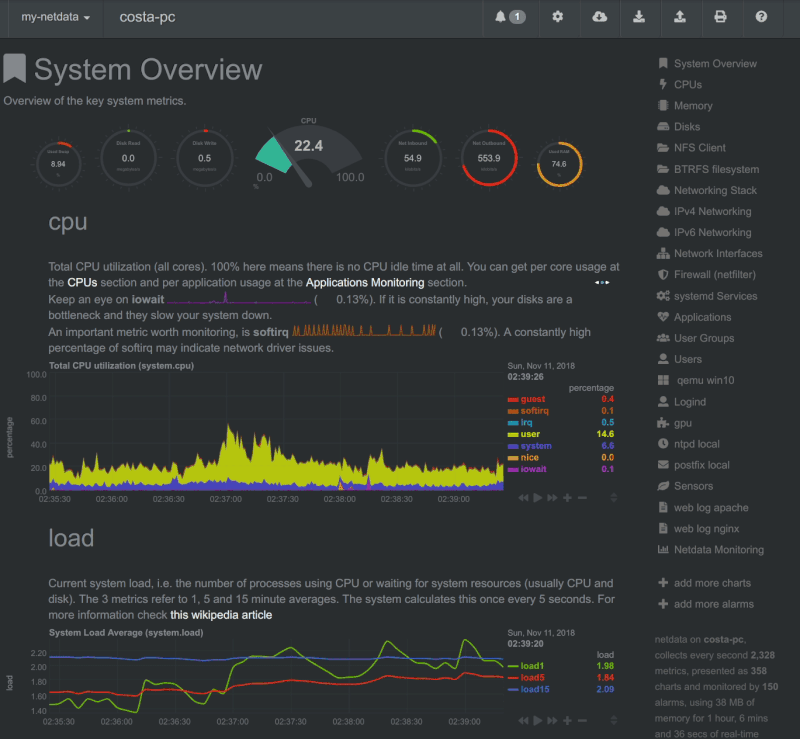
A typical Netdata dashboard, in 1:1 timing. Charts can be panned by dragging them, zoomed in/out with
SHIFT+mouse wheel, an area can be selected for zoom-in withSHIFT+mouse selection. Netdata is highly interactive, real-time, and optimized to get the work done!
Want to see Netdata live? Check out any of our live demos.
Netdata is used by hundreds of thousands of users all over the world. Check our GitHub watchers list. You will find people working for Amazon, Atos, Baidu, Cisco Systems, Citrix, Deutsche Telekom, DigitalOcean, Elastic, EPAM Systems, Ericsson, Google, Groupon, Hortonworks, HP, Huawei, IBM, Microsoft, NewRelic, Nvidia, Red Hat, SAP, Selectel, TicketMaster, Vimeo, and many more!
We provide Docker images for the most common architectures. These are statistics reported by Docker Hub:
When you install multiple Netdata, they are integrated into one distributed application, via a Netdata registry. This is a web browser feature and it allows us to count the number of unique users and unique Netdata servers installed. The following information comes from the global public Netdata registry we run:
To install Netdata from source on any Linux system (physical, virtual, container, IoT, edge) and keep it up to date with our nightly releases automatically, run the following:
# make sure you run `bash` for your shell
bash
# install Netdata directly from GitHub source
bash <(curl -Ss https://my-netdata.io/kickstart.sh)
Starting with v1.12, Netdata collects anonymous usage information by default and sends it to Google Analytics. Read about the information collected, and learn how to-opt, on our anonymous statistics page.
The usage statistics are vital for us, as we use them to discover bugs and prioritize new features. We thank you for actively contributing to Netdata's future.
To learn more about the pros and cons of using nightly vs. stable releases, see our notice about the two options.
The above command will:
More installation methods and additional options can be found at the installation page.
To try Netdata in a Docker container, run this:
docker run -d --name=netdata \
-p 19999:19999 \
-v /etc/passwd:/host/etc/passwd:ro \
-v /etc/group:/host/etc/group:ro \
-v /proc:/host/proc:ro \
-v /sys:/host/sys:ro \
-v /var/run/docker.sock:/var/run/docker.sock:ro \
--cap-add SYS_PTRACE \
--security-opt apparmor=unconfined \
netdata/netdata
For more information about running Netdata in Docker, check the docker installation page.

From Netdata v1.12 and above, anonymous usage information is collected by default and sent to Google Analytics. To read more about the information collected and how to opt-out, check the anonymous statistics page.
Netdata has a quite different approach to monitoring.
Netdata is a monitoring agent you install on all your systems. It is:
All the above, are packaged together in a very flexible, extremely modular, distributed application.
This is how Netdata compares to other monitoring solutions:
| Netdata | others (open-source and commercial) |
|---|---|
| High resolution metrics (1s granularity) | Low resolution metrics (10s granularity at best) |
| Monitors everything, thousands of metrics per node | Monitor just a few metrics |
| UI is super fast, optimized for anomaly detection | UI is good for just an abstract view |
| Long-term, autonomous storage at one-second granularity | Centralized metrics in an expensive data lake at 10s granularity |
| Meaningful presentation, to help you understand the metrics | You have to know the metrics before you start |
| Install and get results immediately | Long preparation is required to get any useful results |
| Use it for troubleshooting performance problems | Use them to get statistics of past performance |
| Kills the console for tracing performance issues | The console is always required for troubleshooting |
| Requires zero dedicated resources | Require large dedicated resources |
Netdata is open-source, free, super fast, very easy, completely open, extremely efficient, flexible and integrate-able.
It has been designed by system administrators, DevOps engineers, and developers for to not just visualize metrics, but also troubleshoot complex performance problems.
April 6, 2020 - Netdata v1.21.0 released!
Release v1.21.0 contains 2 new collectors, 3 new exporting connectors, 37 bug fixes, 46 improvements, and 25 documentation updates. We also made 26 bug fixes or improvements related to the upcoming release of Netdata Cloud.
We added a new collector for Apache Pulsar, a popular open-source distributed pub-sub messaging system. We use Pulsar in our Netdata Cloud infrastructure (more on that later this month!), and are excited to start sharing metrics about our own Pulsar systems when the time comes. The Pulsar collector attempts to auto-detect any running Pulsar processes, but you can always configure the collector based on your setup.
Also new in v1.21 is a VerneMQ collector. We use the open-source MQ Telemetry Transport (MQTT) broker for Netdata Cloud as well. As with Pulsar, you can configure the VerneMQ collector to auto-detect your installation in just a few steps.
Our experimental exporting engine received significant updates with new connectors for Prometheus remote write, MongoDB, and AWS Kinesis Data Streams. You can now send Netdata metrics to more than 20 additional external storage providers for long-term archiving and deeper analysis. Learn more about the exporting engine in our documentation.
We upgraded our TLS compatibility to include 1.3, which applies to HTTPS for both Netdata's web server and streaming connections. TLS 1.3 is the most up-to-date version of the TLS protocol, and contains important fixes and improvements to ensure strong encryption. If you enabled TLS in the web server or streaming, Netdata attempts to use 1.3 by default, but you can also set the version and ciphers explicitly. Learn more in the documentation.
The Netdata dashboard has been completely re-written in React. While the look and behavior hasn't changed, these under-the-hood changes enable a suite of new features, UX improvements, and design overhauls. With React, we'll be able to work faster and better resource our talented engineers.
As part of the ongoing work to polish our eBPF collector tech preview, we've now proven the collector's performance is very good, and have vastly expanded the number of operating system versions the collector works on. Learn how to enable it in our documentation. We've also extensively stress-tested the eBPF collector and found that it's impressively fast given the depth of metrics it collects! Read up on our benchmarking analysis on GitHub.
See more news and previous releases at our blog or our releases page.
Netdata is a highly efficient, highly modular, metrics management engine. Its lockless design makes it ideal for concurrent operations on the metrics.
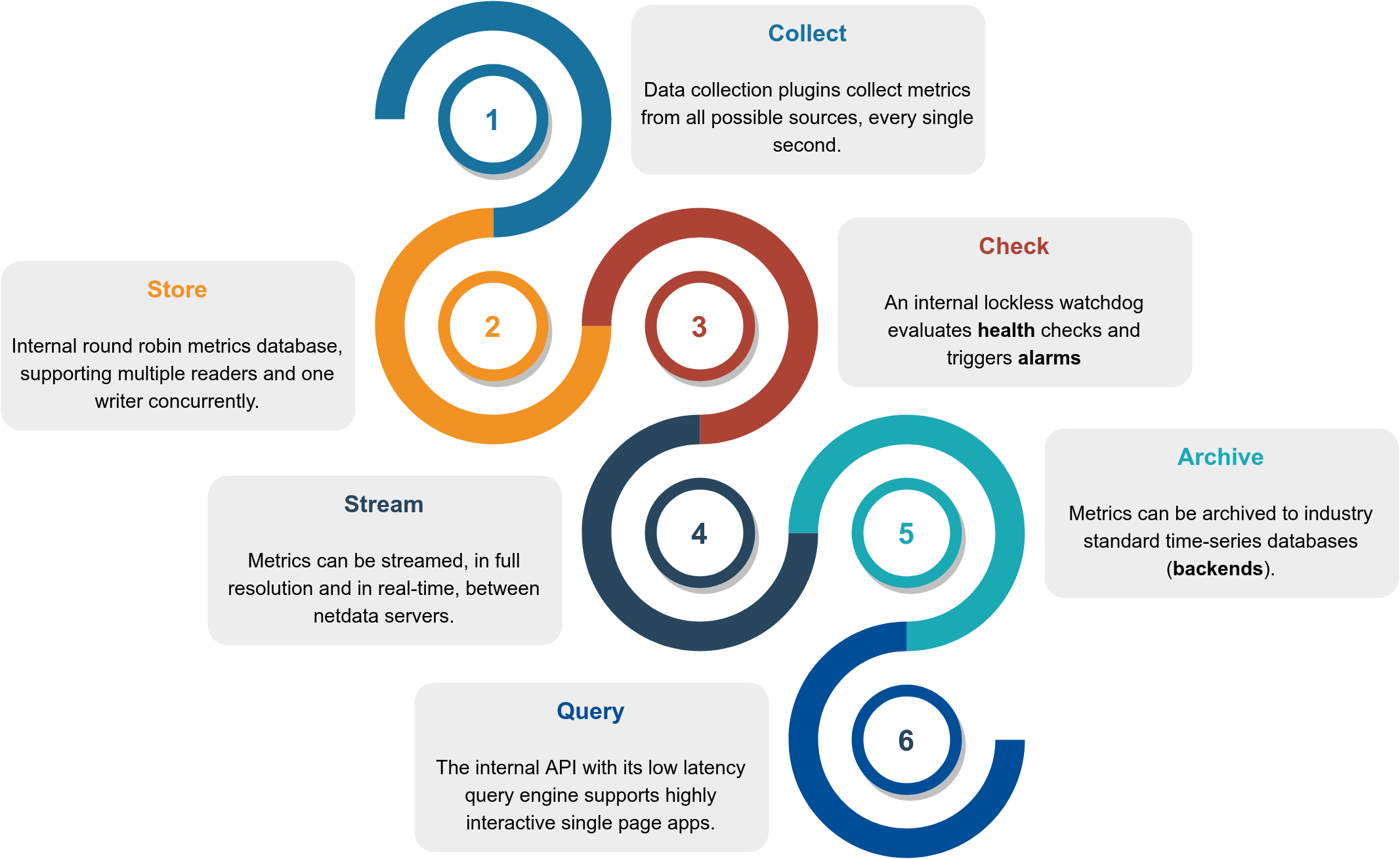
This is how it works:
| Function | Description | Documentation |
|---|---|---|
| Collect | Multiple independent data collection workers are collecting metrics from their sources using the optimal protocol for each application and push the metrics to the database. Each data collection worker has lockless write access to the metrics it collects. | collectors |
| Store | Metrics are first stored in RAM in a custom database engine that then "spills" historical metrics to disk for efficient long-term metrics storage. | database |
| Check | A lockless independent watchdog is evaluating health checks on the collected metrics, triggers alarms, maintains a health transaction log and dispatches alarm notifications. | health |
| Stream | A lockless independent worker is streaming metrics, in full detail and in real-time, to remote Netdata servers, as soon as they are collected. | streaming |
| Archive | A lockless independent worker is down-sampling the metrics and pushes them to backend time-series databases. | backends |
| Query | Multiple independent workers are attached to the internal web server, servicing API requests, including data queries. | web/api |
The result is a highly efficient, low-latency system, supporting multiple readers and one writer on each metric.
This is a high level overview of Netdata feature set and architecture. Click it to to interact with it (it has direct links to our documentation).
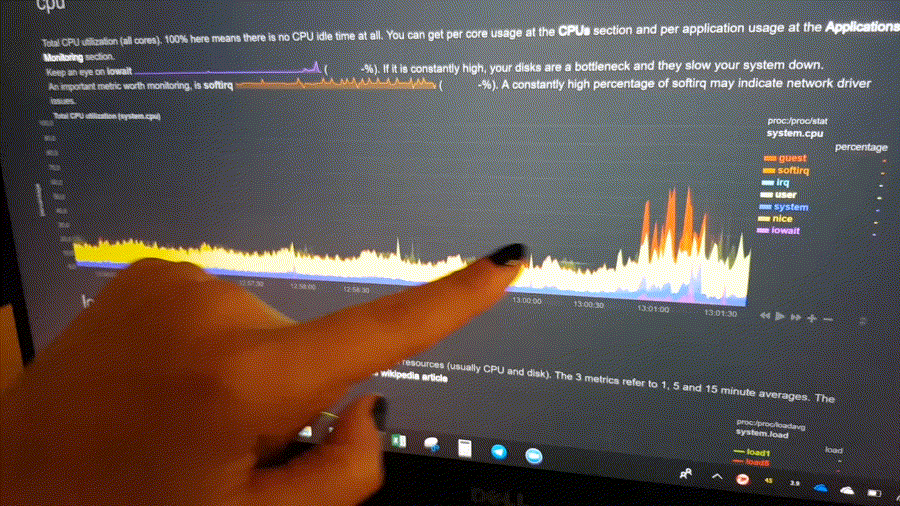
This is what you should expect from Netdata:
error and access logs.slate (dark) and white.To improve clarity on charts, Netdata dashboards present positive values for metrics representing read, input,
inbound, received and negative values for metrics representing write, output, outbound, sent.
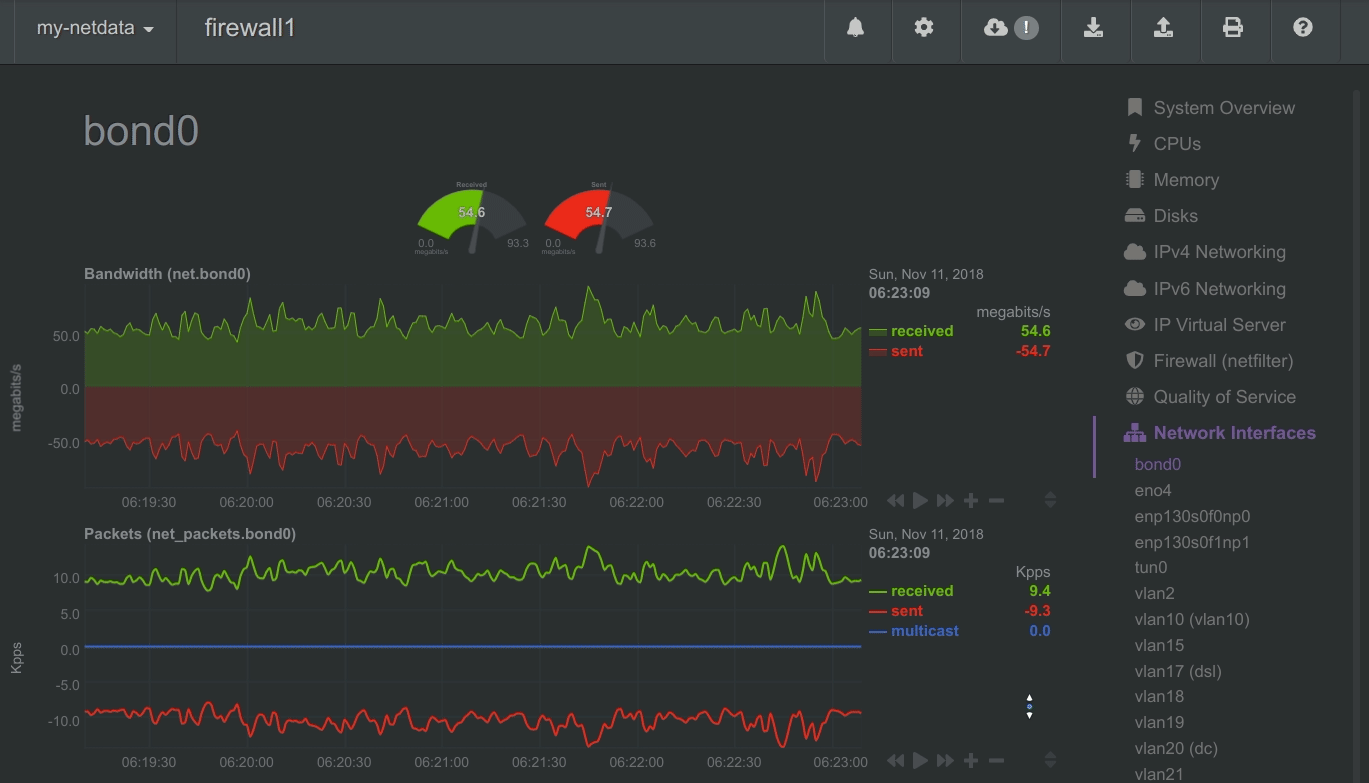
Netdata charts showing the bandwidth and packets of a network interface. received is positive and sent is
negative.
Netdata charts automatically zoom vertically, to visualize the variation of each metric within the visible time-frame.
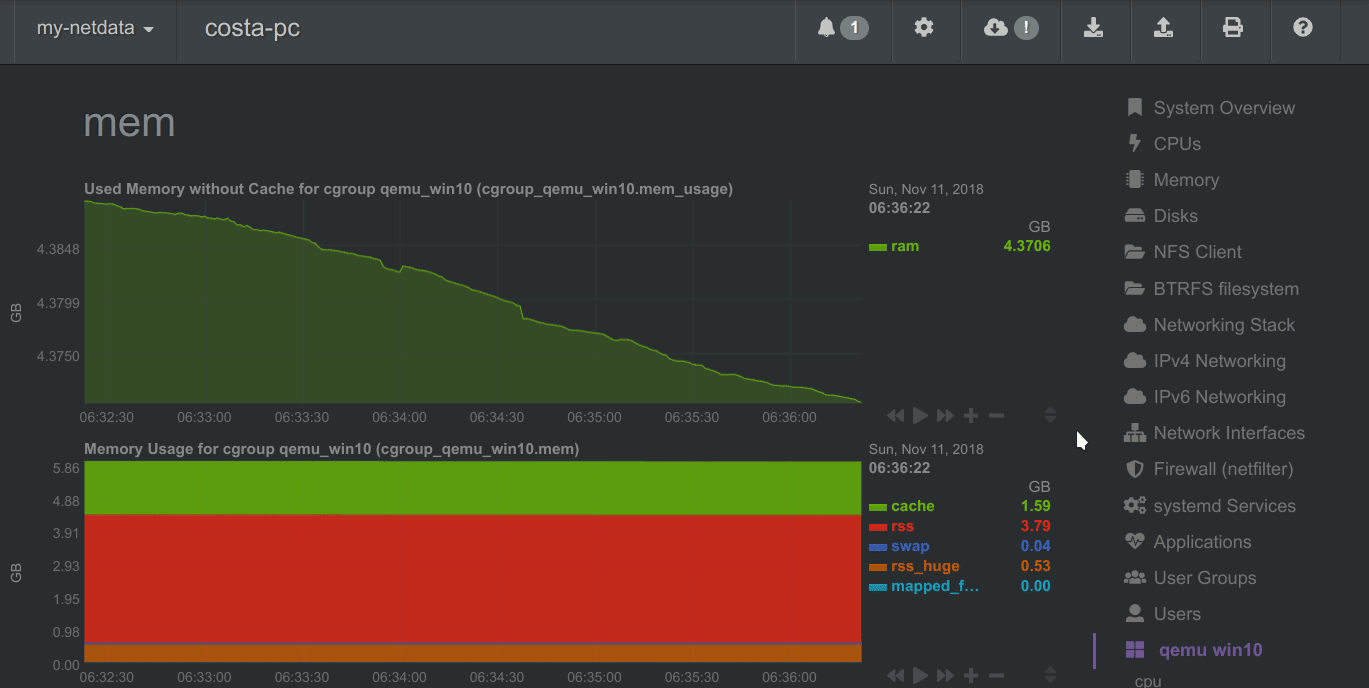
A zero-based stacked chart, automatically switches to an auto-scaled area chart when a single dimension is
selected.
Charts on Netdata dashboards are synchronized to each other. There is no master chart. Any chart can be panned or zoomed at any time, and all other charts will follow.
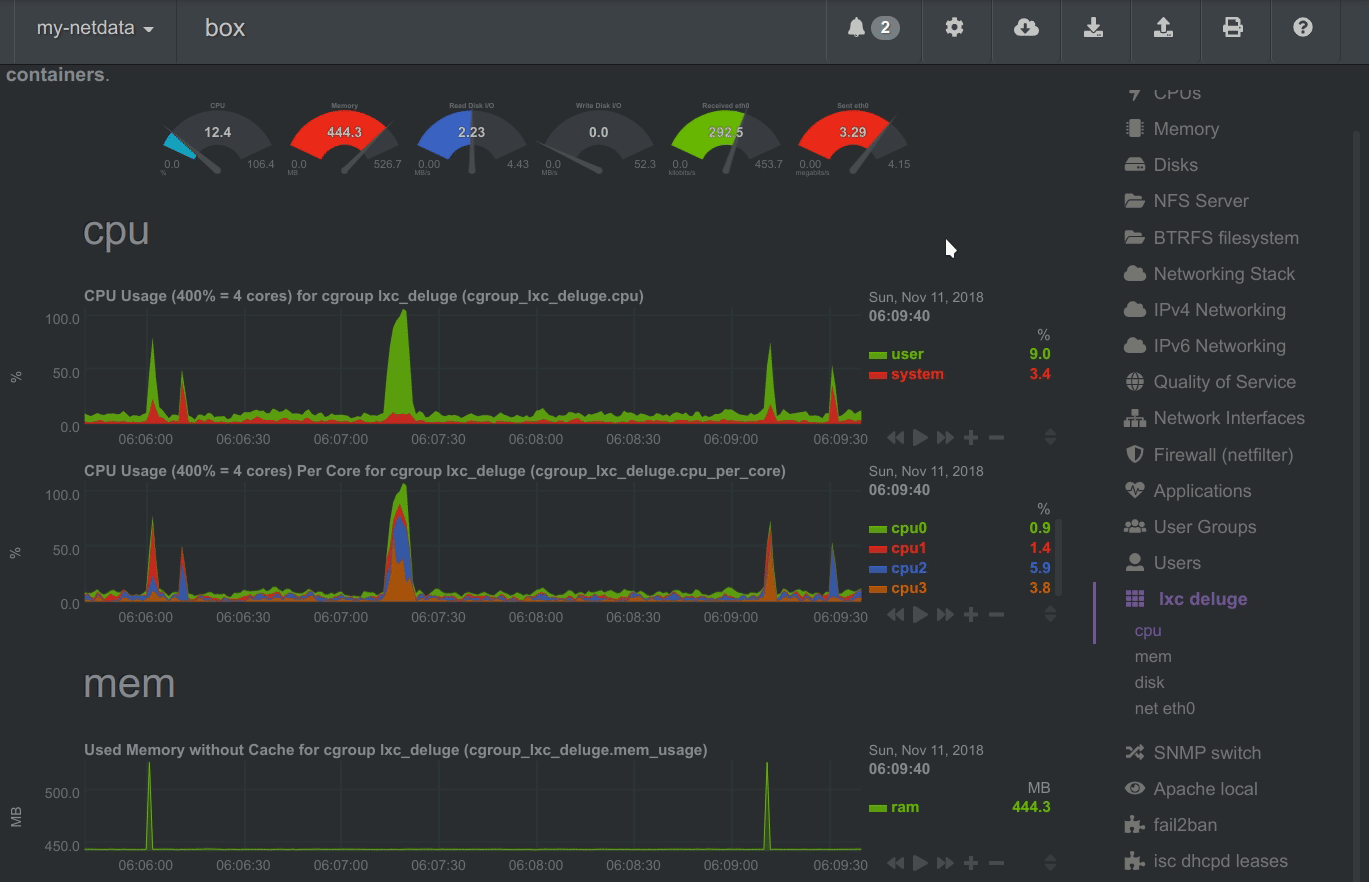
Charts are panned by dragging them with the mouse. Charts can be zoomed in/out withSHIFT + mouse wheel while the
mouse pointer is over a chart.
The visible time-frame (pan and zoom) is propagated from Netdata server to Netdata server when navigating via the My nodes menu.
To improve visual anomaly detection across charts, the user can highlight a time-frame (by pressing Alt + mouse selection) on all charts.
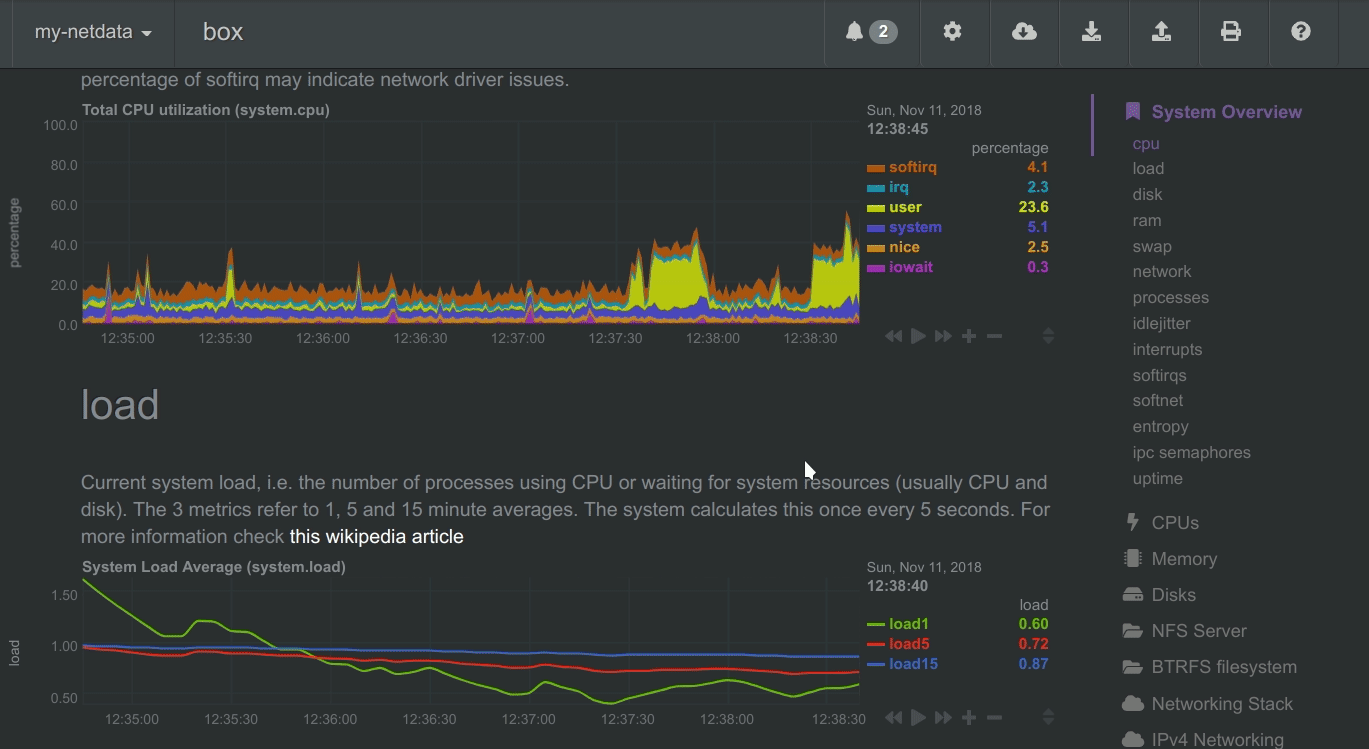
A highlighted time-frame can be given by pressing Alt + mouse selection on any chart. Netdata will highlight the
same range on all charts.
Highlighted ranges are propagated from Netdata server to Netdata server, when navigating via the My nodes menu.
Netdata can collect metrics from 200+ popular services and applications, on top of dozens of system-related metrics jocs, such as CPU, memory, disks, filesystems, networking, and more. We call these collectors, and they're managed by plugins, which support a variety of programming languages, including Go and Python.
Popular collectors include Nginx, Apache, MySQL, statsd, cgroups (containers, Docker, Kubernetes,
LXC, and more), Traefik, web server access.log files, and much more.
See the full list of supported collectors.
Netdata's data collection is extensible, which means you can monitor anything you can get a metric for. You can even write a collector for your custom application using our plugin API.
The Netdata documentation is at https://docs.netdata.cloud, but you can also find each page inside of Netdata's
repository itself in Markdown (.md) files. You can find all our documentation by navigating the repository.
Here is a quick list of notable documents:
| Directory | Description |
|---|---|
installer |
Instructions to install Netdata on your systems. |
docker |
Instructions to install Netdata using docker. |
daemon |
Information about the Netdata daemon and its configuration. |
collectors |
Information about data collection plugins. |
health |
How Netdata's health monitoring works, how to create your own alarms and how to configure alarm notification methods. |
streaming |
How to build hierarchies of Netdata servers, by streaming metrics between them. |
backends |
Long term archiving of metrics to industry-standard time-series databases, like prometheus, graphite, opentsdb. |
web/api |
Learn how to query the Netdata API and the queries it supports. |
web/api/badges |
Learn how to generate badges (SVG images) from live data. |
web/gui/custom |
Learn how to create custom Netdata dashboards. |
web/gui/confluence |
Learn how to create Netdata dashboards on Atlassian's Confluence. |
You can also check all the other directories. Most of them have plenty of documentation.
We welcome contributions. Feel free to join the team!
To report bugs or get help, use GitHub's issues.
You can also find Netdata on:
Netdata is GPLv3+.
Netdata re-distributes other open-source tools and libraries. Please check the third party licenses.
Yes.
When people first hear about a new product, they frequently ask if it is any good. A Hacker News user remarked:
Note to self: Starting immediately, all raganwald projects will have a “Is it any good?” section in the readme, and the answer shall be “yes.".
So, we follow the tradition...
These people seem to like it.
此处可能存在不合适展示的内容,页面不予展示。您可通过相关编辑功能自查并修改。
如您确认内容无涉及 不当用语 / 纯广告导流 / 暴力 / 低俗色情 / 侵权 / 盗版 / 虚假 / 无价值内容或违法国家有关法律法规的内容,可点击提交进行申诉,我们将尽快为您处理。